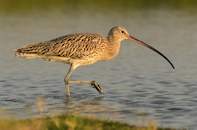
Curlew
Name
Curlew (Numenius arquata)
Family
Scolopacidae
Length
59 cm
Curlew Description
The adult curlew is a mottled black and light chestnut with the neck, chest and breast buff streaked with chestnut and greyish. The rump and underparts are white and the eyes brown. It has a very long downward curved greyish bill and greenish-grey legs. Males are smaller than females. The immature curlew is heavily mottled above.
Curlew Migration
The curlew is a non-breeding summer migrant from the Palaearctic (Europe and Asia north of the Himalayas) to the South African coasts and larger vleis. They over-winter fairly regularly.
Curlew Breeding
The female lay between 3 and 6 eggs in April or May and incubation is about a month. The eggs are a deep ivory with scattered dark markings.
Curlew Habitat
The curlew is found along the shore, estuaries and tidal parts of rivers and also along inland waters.
Curlew Status
It is a near threatened specie.
Curlew Distribution
The curlew is found at the coast and estuaries as well as next to inland waters. It is also found throughout south-eastern Africa.

